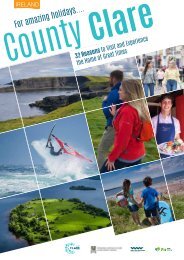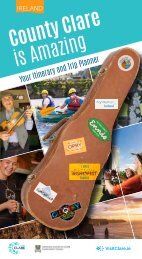Burren and Cliffs of Moher UNESCO Global Geoark Articles 2023
A series of informative articles written by Dr. Eamon Doyle on various Earth and Ocean Sciences in the Burren and Cliffs of Moher UNESCO Global Geopark
A series of informative articles written by Dr. Eamon Doyle on various Earth and Ocean Sciences in the Burren and Cliffs of Moher UNESCO Global Geopark
You also want an ePaper? Increase the reach of your titles
YUMPU automatically turns print PDFs into web optimized ePapers that Google loves.
Managed By<br />
Supported By
The <strong>Burren</strong> <strong>and</strong> <strong>Cliffs</strong> <strong>of</strong> <strong>Moher</strong> <strong>UNESCO</strong><br />
<strong>Global</strong> Geopark team would like to wish<br />
you all a wonderful, healthy, <strong>and</strong> sustainable<br />
Christmas.<br />
As a gift from us, here is a collection <strong>of</strong><br />
interesting & insightful articles about our<br />
wonderful Geopark which were written by<br />
our resident Geologist Dr. Eamon Doyle.<br />
We hope that you enjoy them.
Mud Ripples<br />
Sedimentology is the study <strong>of</strong> how water (<strong>and</strong> wind or<br />
ice) erodes, transports <strong>and</strong> deposits sediment such as clay,<br />
silt, s<strong>and</strong> <strong>and</strong> even boulders or a chemical precipitate.<br />
Studying sedimentology is vital to underst<strong>and</strong>ing the<br />
processes that formed ancient sedimentary rocks. The<br />
laws <strong>of</strong> gravity <strong>and</strong> fluid dynamics haven’t changed over<br />
time <strong>and</strong> the study <strong>of</strong> sedimentology is heavily influenced<br />
by the study <strong>of</strong> modern sedimentary processes. In<br />
sedimentology, the present is the key to the past.<br />
While the rules <strong>of</strong> physics haven’t changed over time,<br />
the surface <strong>of</strong> the Earth has, <strong>and</strong> the variety <strong>of</strong> different<br />
environments has changed too. This adds an element <strong>of</strong><br />
uncertainty to interpreting ancient environments, as some<br />
proccesses may have operated in combinations that we<br />
don’t see today. For example, we take the surface covering<br />
<strong>of</strong> plants on Earth today for granted, but 500 million years<br />
ago there were no l<strong>and</strong> plants holding surface sediment<br />
together so erosion would have been more intense.<br />
The good news is that everybody can be a<br />
sedimentologist! Just go to your nearest beach <strong>and</strong> watch<br />
how the patterns in the s<strong>and</strong> change over a day. The most<br />
common sedimentary features on beaches are ripples.<br />
Ripples are the irregular ridges <strong>of</strong> s<strong>and</strong> that are shaped by<br />
the changing tidal currents <strong>and</strong> waves on a beach. They<br />
come in a wide variety <strong>of</strong> shapes <strong>and</strong> sizes <strong>and</strong> over the<br />
last hundred years the different conditions that produce<br />
different ripples in s<strong>and</strong> have been very well understood.<br />
Much <strong>of</strong> the work was done in laboratories using artificial<br />
s<strong>and</strong>, <strong>and</strong> currents <strong>of</strong> different strengths flowing in<br />
confined structures known as ‘flumes’ as well as observing<br />
modern processes on beaches <strong>and</strong> rivers.<br />
Typical ancient ripples that formed in the same way as<br />
the ripples on your beach can be seen on some <strong>of</strong> the<br />
<strong>Moher</strong> flagstones that make the barrier wall at the <strong>Cliffs</strong> <strong>of</strong><br />
<strong>Moher</strong>.<br />
Mud ripples are a bit different <strong>and</strong> far more rare. Until<br />
very recently they had never been found in Irel<strong>and</strong>. We<br />
were delighted to find some here a couple <strong>of</strong> years ago<br />
<strong>and</strong> have recently published a paper in the Irish Journal <strong>of</strong><br />
Earth Sciences on their significance.<br />
Mud ripples were named that because they superficially<br />
resemble normal ripples. However, they are formed under<br />
different <strong>and</strong> very particular circumstances; when erosive<br />
currents flow over semi-consolidated mud. The currents<br />
erode parallel rows <strong>of</strong> pits perpendicular to the current<br />
direction, these then get buried as the current wanes <strong>and</strong><br />
the sediment being carried is deposited, filling in the<br />
pits. So they are formed by single event flows, essentially<br />
floods, that can happen underwater <strong>and</strong> far <strong>of</strong>fshore,<br />
sometimes triggered by heavy rainfall on l<strong>and</strong> that caused<br />
sediment-laden rivers to flood into the sea.<br />
These mud ripples are evidence <strong>of</strong> monsoonal rains that<br />
fell 318 million years ago when we were near the equator.<br />
Figure caption: 318 million year old mud ripples from the Gull Isl<strong>and</strong> Formation, found near Slieve Elva.
Geology Evening Course. Stone, Water <strong>and</strong><br />
Ice: The <strong>Burren</strong> – A l<strong>and</strong>scape shaped by Time<br />
Over the last dozen years the <strong>Burren</strong> <strong>and</strong> <strong>Cliffs</strong> <strong>of</strong> <strong>Moher</strong><br />
<strong>UNESCO</strong> <strong>Global</strong> Geopark has run an evening course with<br />
the <strong>Burren</strong> Outdoor Education <strong>and</strong> Training Centre in<br />
Turlough, Bell Harbour. The aim <strong>of</strong> this course is to make<br />
the geology <strong>of</strong> the area accessible to all those who have an<br />
interest in the <strong>Burren</strong> l<strong>and</strong>scape <strong>and</strong> a couple <strong>of</strong> hours free<br />
time in the evening, once a week in Spring. The course has<br />
been hugely successful, with over 200 participants so far,<br />
giving the <strong>Burren</strong> the best-trained population <strong>of</strong> amateur<br />
geologists in Irel<strong>and</strong>.<br />
The desire to underst<strong>and</strong> our surroundings is a very deep<br />
<strong>and</strong> primal urge in humans, <strong>and</strong> faced with the unusual<br />
l<strong>and</strong>scape <strong>of</strong> the <strong>Burren</strong> <strong>and</strong> the spectacular <strong>Cliffs</strong> <strong>of</strong><br />
<strong>Moher</strong> there is little wonder that we want to know how<br />
they formed. To be able to provide this information in a<br />
friendly environment is one <strong>of</strong> the highlights <strong>of</strong> the year<br />
for us.<br />
Keep an eye on the Geopark’s Facebook page for details<br />
on how you can sign up to the 2024 Geology evening<br />
course.<br />
This year’s course started with an introduction to some<br />
basic geological concepts, with the aim <strong>of</strong> getting you to<br />
look at rocks in a totally new way. The next class looked<br />
at the Earth as a whole <strong>and</strong> how the planet works <strong>and</strong><br />
how the <strong>Burren</strong> fits into a very big picture, including<br />
the recent Earthquakes in Turkey. In class three we<br />
looked at the limestone rocks <strong>of</strong> the <strong>Burren</strong>, with plenty<br />
<strong>of</strong> samples <strong>and</strong> introduced geological maps. Following<br />
that we outlined the geological history <strong>of</strong> the <strong>Cliffs</strong> <strong>of</strong><br />
<strong>Moher</strong> <strong>and</strong> got a chance to examine local fossils <strong>and</strong> their<br />
significance. Week five, our guest lecture spot, was an<br />
important part <strong>of</strong> the course, where we invited experts<br />
who have worked in the <strong>Burren</strong> to share their expertise.<br />
This year Dr. John Murray (University <strong>of</strong> Galway) <strong>and</strong> Dr.<br />
Bre<strong>and</strong>án MacGabhann (University <strong>of</strong> Limerick) spoke<br />
about a fascinating local fossil which Dr. Eamon Doyle<br />
was fortunate enough to be involved with <strong>and</strong> which has<br />
been published recently in an international academic<br />
fossil journal. We snuck in a local fieldtrip for half a day<br />
on Sunday before returning to the classroom on April 4th<br />
for the final class on <strong>Burren</strong> l<strong>and</strong>scape, caves <strong>and</strong> karst.<br />
The course was presented by Dr. Eamon Doyle, the<br />
Geopark geologist <strong>and</strong> Colin Bunce the <strong>Burren</strong> cave<br />
expert. Between them they have asked most <strong>of</strong> the<br />
questions you are likely to ask <strong>and</strong> found answers to many<br />
<strong>of</strong> them, which they enjoy sharing.<br />
The course is supported by the <strong>Burren</strong> <strong>and</strong> <strong>Cliffs</strong> <strong>of</strong> <strong>Moher</strong><br />
<strong>UNESCO</strong> <strong>Global</strong> Geopark managed by Clare County<br />
Council, Geological Survey Irel<strong>and</strong>, <strong>Burren</strong> Outdoor<br />
Education <strong>and</strong> Training Centre <strong>and</strong> the Limerick <strong>and</strong><br />
Clare Education <strong>and</strong> Training Board.<br />
Figure caption: Evening Course fieldtrip looking at local rocks at Fanore Beach
The secrets <strong>of</strong> Lough Inchiquin<br />
Lough Inchiquin is a wonderful, relatively deep lake<br />
on the edge <strong>of</strong> the <strong>Burren</strong>. It has challenged trout <strong>and</strong><br />
pike fishermen for generations <strong>and</strong> provides a relaxing<br />
amenity for both locals <strong>and</strong> visitors in a beautiful setting.<br />
However, most visitors don’t realise that deep within<br />
Lough Inchiquin are hidden secrets, buried in the mud at<br />
the bottom <strong>of</strong> the lake.<br />
These secrets are biological <strong>and</strong> chemical information<br />
continuously stored in the mud over thous<strong>and</strong>s <strong>of</strong> years.<br />
Lakes act like l<strong>and</strong>scape storage devices; rivers flowing<br />
into a lake slow down <strong>and</strong> anything carried in by those<br />
rivers can be deposited on the lake floor. The rivers that<br />
flow into a lake contain the chemical <strong>and</strong> biological<br />
imprint <strong>of</strong> the l<strong>and</strong> they are draining because much <strong>of</strong><br />
what happens on the l<strong>and</strong> surface gets washed into rivers,<br />
particularly during heavy rain events.<br />
Lough Inchiquin has been fed by rivers flowing <strong>of</strong>f the<br />
<strong>Burren</strong> since the end <strong>of</strong> the last Ice age, this means we<br />
have a record <strong>of</strong> what was happening on the surface<br />
<strong>of</strong> the <strong>Burren</strong> stored in the mud at the bottom <strong>of</strong> the<br />
lake. By analysing the layers <strong>of</strong> mud for biological <strong>and</strong><br />
chemical signals it is possible to build up a story <strong>of</strong> how<br />
these signals change over long periods <strong>of</strong> time <strong>and</strong> to<br />
underst<strong>and</strong> what was happening in the <strong>Burren</strong> l<strong>and</strong>scape<br />
thous<strong>and</strong>s <strong>of</strong> years ago.<br />
The Palaeoenvironmental Research Unit at University<br />
<strong>of</strong> Galway did just that. Funded by the Irish Research<br />
Council the team extracted a 10m sediment core from the<br />
deepest part <strong>of</strong> the lake (30m). Plant material for Carbon<br />
14 dating was extracted to identify the age <strong>of</strong> the mud<br />
layers. They then examined the preserved chironomid<br />
fly larvae. These insects are important for analysing<br />
past climate as different species prefer different water<br />
conditions. The preserved pollen <strong>and</strong> the chemistry <strong>of</strong> the<br />
mud was also analyzed.<br />
The Carbon 14 data revealed that the core spanned<br />
over 4,000 years from the Late Mesolithic to the Late<br />
Bronze Age (4,500 to 660 BC). Analysis <strong>of</strong> the deepest<br />
(<strong>and</strong> therefore oldest) part <strong>of</strong> the core suggested mostly<br />
woodl<strong>and</strong> vegetation, with little grass <strong>and</strong> very little<br />
nutrient input from 4,500 to 3,100 BC. However, in the<br />
time period from the Late Neolithic to the Early Bronze<br />
Age (2,870-1700 BC) they found pollen from cereal<br />
suggesting widespread farming was taking place, a change<br />
in the type <strong>of</strong> insects indicating increased amount <strong>of</strong><br />
nutrients (from soil) being washed into the lake <strong>and</strong> a<br />
decrease in tree pollen.<br />
This confirms that the people that built many <strong>of</strong> the<br />
wonderful tombs in the <strong>Burren</strong> during the Bronze Age<br />
were actively working the l<strong>and</strong> as farmers <strong>and</strong> this<br />
resulted in significant loss <strong>of</strong> soil at that time, a particular<br />
risk for thin limestone soils in a karst environment like<br />
the <strong>Burren</strong>. Modern farming practices in the <strong>Burren</strong><br />
minimize those risks.<br />
This study is an important reminder that the actions <strong>of</strong><br />
humans can have a long-term impact on the environment,<br />
the evidence <strong>of</strong> which will live on long after us.<br />
Figure caption: Lough Inchiquin, Cor<strong>of</strong>in.
Fishing for clues to ancient marine<br />
biodiversity<br />
Finding fossils can be compared to fishing; the chances<br />
<strong>of</strong> catching anything are small but the results are <strong>of</strong>ten<br />
amazing. Most animals that lived millions <strong>of</strong> years ago are<br />
not preserved as fossils, they were either eaten by other<br />
animals or decomposed by bacteria.<br />
Unravelling the biodiversity <strong>of</strong> ancient seas that no longer<br />
exist can therefore be difficult. Recent discoveries are<br />
shedding new light on the fish that swam in the ancient<br />
seas that eventually turned to rock to form the <strong>Burren</strong> <strong>and</strong><br />
<strong>Cliffs</strong> <strong>of</strong> <strong>Moher</strong>. Previously, nothing was known about the<br />
fish that lived here 320 million years ago.<br />
We now know we had sharks. Sharks have a body made <strong>of</strong><br />
cartilage, which is only rarely preserved <strong>and</strong> usually only<br />
their teeth are preserved as fossils. The 2cm shark tooth<br />
pictured here has a main central point <strong>and</strong> lateral pointed<br />
cusps. This is the tooth <strong>of</strong> a shark that was designed to<br />
grip <strong>and</strong> it would have been an active hunter <strong>of</strong> slippery<br />
creatures, probably other fish. The shark would have been<br />
over 1m long.<br />
In addition to this shark we now know we had other,<br />
much smaller sharks. They had teeth only 1mm long but<br />
despite their size they would also have been active hunters<br />
<strong>of</strong> swimming creatures. Interestingly, we know they had<br />
large eyes, so they would have been able to hunt in darker,<br />
deeper water. They would have been predators <strong>of</strong> smaller<br />
creatures but the prey <strong>of</strong> the larger sharks.<br />
Some sharks do not have sharp teeth, they have flat hard<br />
plates that are used to crush shells. These fish would have<br />
lived near the bottom <strong>of</strong> the sea, taking their prey, such as<br />
snails, from the seafloor. These may have hunted by scent<br />
rather than eyesight.<br />
Apart from sharks, we also have examples <strong>of</strong> fossil fish<br />
that are the ancestors <strong>of</strong> all four-legged creatures. These<br />
fish have fins that are lobes <strong>and</strong> it is from this group <strong>of</strong><br />
fish that tetrapods evolved by transforming the bones in<br />
their fins to the bones that became the arms <strong>and</strong> legs <strong>of</strong><br />
dinosaurs, elephants <strong>and</strong> ourselves.<br />
Finally, we now know we have fish fossils that are the<br />
ancestors <strong>of</strong> what would become the most common type<br />
<strong>of</strong> fish swimming today such as cod, salmon, herring etc.<br />
These would have eaten a broad variety <strong>of</strong> food <strong>and</strong> would<br />
have been prey themselves, however they had much<br />
tougher scales than most <strong>of</strong> our modern fish, so would<br />
not have been easy prey.<br />
The rocks <strong>of</strong> the <strong>Burren</strong> <strong>and</strong> <strong>Cliffs</strong> <strong>of</strong> <strong>Moher</strong> are revealing<br />
that there was a complexity to the biodiversity <strong>of</strong> the fish,<br />
<strong>and</strong> therefore their prey, that we were previously unaware<br />
<strong>of</strong> in those ancient seas.<br />
We are currently losing the biodiversity <strong>of</strong> fish in our<br />
modern seas <strong>and</strong> oceans due to over-fishing, pollution<br />
<strong>and</strong> climate change. What legacy will be preserved as<br />
fossils for future generations to find?<br />
Figure caption: Fossil shark tooth from near Doolin.
Geopark Academy conference in Kilfenora<br />
The <strong>Burren</strong> has a wonderful history <strong>of</strong> learning that is<br />
kept alive today by groups such as the <strong>Burren</strong> <strong>and</strong> <strong>Cliffs</strong><br />
<strong>of</strong> <strong>Moher</strong> <strong>UNESCO</strong> <strong>Global</strong> Geopark, the <strong>Burren</strong> College<br />
<strong>of</strong> Art, Caherconnell Archaeology Field School, North<br />
Clare Historical Society, the <strong>Burren</strong>beo Trust all our<br />
National <strong>and</strong> Secondary schools, the local participants in<br />
the BT Young Scientist competition as well as individual<br />
specialists.<br />
Over the years, lots <strong>of</strong> people have come <strong>and</strong> gone from<br />
the <strong>Burren</strong>, exploring, searching <strong>and</strong> discovering. Some,<br />
such as Tim Robinson have left a mark (<strong>and</strong> a map)<br />
that is universally recognized <strong>and</strong> valued, but for many<br />
other students <strong>and</strong> researchers the information they<br />
find gets a little lost in libraries <strong>and</strong> obscure academic<br />
journals, <strong>and</strong> <strong>of</strong>ten that information is only presented<br />
once at a conference in one <strong>of</strong> our national universities<br />
or sometimes an international conference. For many<br />
<strong>of</strong> us, attending these events is not possible, even if we<br />
knew when they were happening, so inevitably we miss<br />
out on some very good research that is happening in our<br />
neighbourhood.<br />
The <strong>Burren</strong> <strong>and</strong> <strong>Cliffs</strong> <strong>of</strong> <strong>Moher</strong> <strong>UNESCO</strong> <strong>Global</strong><br />
Geopark is one <strong>of</strong> the many groups that value research<br />
in the region. We work with national <strong>and</strong> international<br />
universities <strong>and</strong> researchers <strong>and</strong> we were pleased to<br />
bring some <strong>of</strong> this information to the public on May<br />
27th/28th <strong>of</strong> this year. Called the Geopark Academy, this<br />
free conference was held in Kilfenora Community Hall<br />
on the Saturday <strong>and</strong> there was a Fieldtrip on the Sunday.<br />
We provided this opportunity for people who might not<br />
usually attend conferences to come along <strong>and</strong> hear about<br />
the work <strong>and</strong> research a diverse group <strong>of</strong> people are doing<br />
in the area.<br />
The Geopark Academy conference covered a broad range<br />
<strong>of</strong> subjects from geology, to archaeology <strong>and</strong> biology <strong>and</strong><br />
even music. There was plenty <strong>of</strong> opportunity to engage<br />
with the speakers in an informal setting <strong>and</strong> to provide<br />
them with some local knowldege they are unaware <strong>of</strong>!<br />
Dr. Eamon Doyle was talking about some <strong>of</strong> the newest<br />
fossils he has found. Other speakers spoke about recent<br />
archaeology, using new technology in caves in the <strong>Burren</strong>,<br />
ancient sediment in Lake Inchiquin, the invertebrates<br />
that are so important that we <strong>of</strong>ten overlook, <strong>and</strong> what<br />
happens to the stuff we flush into the water; the impact <strong>of</strong><br />
micro-plastics in the sea <strong>of</strong> the Clare coast.<br />
The fieldtrip on Sunday 28th was lead by Dr. Gordon<br />
Bromley <strong>and</strong> Dr. Tiernan Henry (University <strong>of</strong> Galway)<br />
<strong>and</strong> included a variety <strong>of</strong> locations that provided<br />
information about the last Ice Age in the <strong>Burren</strong> <strong>and</strong> the<br />
unique way water travels in the <strong>Burren</strong>. There were plenty<br />
chats <strong>and</strong> general discussions along the way!<br />
Keep an eye on the Geopark’s Facebook page for<br />
information regarding the Geopark Academy which will<br />
be coming back in 2024.<br />
Dr. Daisy Spencer, palaeoenvironmental research unit, university <strong>of</strong> Galway is closing the presentations at the Geopark Academy <strong>2023</strong> with an in<br />
depth look at pollen <strong>and</strong> chironimids <strong>of</strong> sediment cores from Lough Inchiquin <strong>and</strong> what they tell us about ancient farming
Ostracods; tiny arthropods in shells<br />
The Clare Shale Formation is a geological unit <strong>of</strong> rock<br />
that extends from Doolin to Slieve Elva <strong>and</strong> Corr<strong>of</strong>in <strong>and</strong><br />
down to the Shannon Estuary. It is a dark rock made <strong>of</strong><br />
thin layers that crumble easily <strong>and</strong> weathers quickly. It is<br />
mud that was turned to rock over 300 million years ago.<br />
The Clare Shale Formation is well known in the geological<br />
community for the fossil ammonoids (also known as<br />
goniatites) which are very abundant in some layers. These<br />
fossils have been studied extensively here because they<br />
are useful for providing information about the age <strong>of</strong> the<br />
rocks where they are found. However, the attention that<br />
these fossils were given was matched by the almost total<br />
lack <strong>of</strong> attention given to other fossils. One exception<br />
being the work by University <strong>of</strong> Galway palaeontologist,<br />
Dr John Murray <strong>and</strong> his students on fossil conodonts.<br />
One <strong>of</strong> the reasons for this general neglect is that other<br />
fossils are much harder to find, because they are not<br />
very common <strong>and</strong> <strong>of</strong>ten tiny. Over the last few years I<br />
have been able to find an increasing number <strong>and</strong> variety<br />
<strong>of</strong> fossils in the Clare Shales which is telling us that the<br />
biodiversity <strong>of</strong> the sea at that time was much higher than<br />
previously known.<br />
Ostracods are very small (from 0.1 mm to a couple <strong>of</strong><br />
millimetres), so unless you are specifically looking for<br />
them you are unlikely to come across one. They are<br />
unusual because they live inside paired shells (technically<br />
called a carapace), so they look like small bivalve molluscs<br />
(such as mussels) until you see what’s inside. Inside there<br />
is a creature that looks like like a shrimp. Their antennae<br />
<strong>and</strong> legs can protrude from between the shells <strong>and</strong> they<br />
can move about on the seafloor <strong>and</strong> some are excellent<br />
swimmers.<br />
While the shells are very common, we very rarely find the<br />
animals inside in the fossils, they usual decompose before<br />
the fossilization process. The shells have a wide variety <strong>of</strong><br />
forms <strong>and</strong> ornament <strong>and</strong> these are used for identification<br />
<strong>of</strong> fossil ostracods. One <strong>of</strong> the interesting things about<br />
the new fossil ostracods from the Clare Shale is that while<br />
they are very rare (only 10 individuals found so far) there<br />
is at least four different species. Further research is needed<br />
to see if we can identify what particular environment<br />
these fossil ostracods were living in, 320 million years ago.<br />
One <strong>of</strong> my most recent fossil finds belongs to a group <strong>of</strong><br />
animals known as ostracods. Ostracods are arthropods,<br />
that is they have jointed limbs <strong>and</strong> are related to crabs,<br />
spiders, centipedes <strong>and</strong> insects. The oldest known fossil<br />
ostracods are over 450 million years old, they are the most<br />
common fossil arthropods <strong>and</strong> their relatives are still alive<br />
<strong>and</strong> well today in almost every environment where there<br />
is water.<br />
Figure caption: Microscopic fossil ostracod shell (1.5mm wide) from the Clare Shale Formation.
Lingula - a different kind <strong>of</strong> brachiopod<br />
Around the coastlines <strong>of</strong> Asia <strong>and</strong> the Pacific Ocean lives<br />
a brachiopod called Lingula. It inhabits shallow coastal<br />
areas where it burrows into s<strong>and</strong>y or muddy seafloors.<br />
Unlike most other brachiopods it can live in brackish<br />
water habitats such as tidal mud flats. And, unlike any<br />
other brachiopod, it is eaten by humans.<br />
Typically, brachiopods have two hard shells made from<br />
calcium carbonate. Lingula is different in having shells<br />
made from chitin, protein <strong>and</strong> calcium phosphate. This<br />
makes the shells more flexible, a bit like your fingernails.<br />
Lingula is also different than most other brachiopods in<br />
being classified as an ‘inarticulate’ brachiopod. This does<br />
not refer to it’s inability to speak, it refers to the way the<br />
two shells are connected together, or articulate with each<br />
other. The majority <strong>of</strong> brachiopods have complex sockets<br />
<strong>and</strong> corresponding processes in their shells that interlink<br />
with each other to form a rigid hinge mechanism, Lingula<br />
doesn’t. Many brachiopods have a ‘pedicle’; this is a<br />
flexible, leathery stalk that extends from the shell to attach<br />
the brachiopod to a hard substrate. Lingula has a relatively<br />
large pedicle, however it doesn’t use it to attach to rocks,<br />
it uses it to help it burrow into s<strong>and</strong> <strong>and</strong> to to hold the<br />
animal in place in its burrow.<br />
Given these differences it is worth asking why Lingula is<br />
considered to be a brachiopod at all. The reason is that it<br />
has a feeding structure (a ring <strong>of</strong> tentacles) known as a<br />
‘lophophore’ which is common to all brachiopods. This is<br />
one reason why brachiopods are in a different phylum to<br />
oysters <strong>and</strong> mussels, which are molluscs.<br />
Brachiopods similar to Lingula are known from over 500<br />
million years ago. They have survived mass extinction<br />
events, environmental changes <strong>and</strong> predator evolutionary<br />
challenges relatively unchanged. Thier tough flexible shells<br />
held together by strong muscles make them a difficult<br />
subject for predators.<br />
I have found some in the 320 million year old shales from<br />
Doolin to the Spanish Point. Unlike modern Lingula,<br />
many ancient examples are thought to have lived in<br />
relatively deep water <strong>and</strong> they could survive conditions<br />
that other brachiopods couldn’t. So we find them in<br />
rocks that show evidence <strong>of</strong> low oxygen levels <strong>and</strong> high<br />
mud content which other brachiopods could not survive.<br />
Modern Lingula uses a molucule called Hemerythrin<br />
which is similar to our own Haemoglobin in using iron<br />
to bind the oxygen that is vital for living. It is likely the<br />
ancient examples used the same molecule.<br />
Until recently all the fossil brachiopods that looked like<br />
Lingula were called Lingula, however it is now considered<br />
that all the older ones, such as they ones found here in<br />
Clare are a different genus. However, there is currently no<br />
agreement among palaeontologists on how these older<br />
ones should be named. Like the slow-changing evolution<br />
<strong>of</strong> the brachiopod itself, the changing <strong>of</strong> fossil names can<br />
take some time.<br />
Figure caption: The ancient relative <strong>of</strong> the brachiopod Lingula, from the rocks <strong>of</strong> northwest County Clare.
The ancient craft <strong>of</strong> iron smelting at<br />
Caherconnell Fort<br />
Iron is the fourth most abundant element in Earth’s crust,<br />
the thin veneer on the surface <strong>of</strong> the Earth that we live on.<br />
However, it is the most common element on Earth, taken<br />
as a whole, because it is particularly concentrated in the<br />
Earth’s core. All the iron on Earth was formed from fusion<br />
<strong>of</strong> lighter elements in the cores <strong>of</strong> distant supergiant stars<br />
at incredible temperatures <strong>of</strong> billions <strong>of</strong> degrees. The<br />
fusion process stops at iron because it is the most stable<br />
element, this is why iron is so common; it is difficult to<br />
change into other elements.<br />
As the Earth formed from coalescing particles over<br />
four billion years ago, the iron sank to the core where it<br />
remains today. Fresh iron is transferred to the surface<br />
<strong>of</strong> the Earth every time a volcano erupts. Iron combines<br />
readily with oxygen to form iron oxide, also known as<br />
rust, which has a typical red/orange colour. In fact, when<br />
the first oxygen was being formed on Earth by simple<br />
organisms three billion years ago it didn’t actually get to<br />
stay in the atmosphere as it combined with all the iron<br />
on the Earth’s surface. This formed large deposits <strong>of</strong> iron<br />
minerals which are the source <strong>of</strong> most <strong>of</strong> the iron that<br />
is mined on Earth today. It wasn’t until all the iron was<br />
oxidised over a billion years later that oxygen was free to<br />
accumulate in the atmosphere. Our blood now uses iron<br />
in haemoglobin to tranport oxygen to all the cells in our<br />
body.<br />
Thous<strong>and</strong>s <strong>of</strong> years ago, one <strong>of</strong> our ancestors noticed that<br />
burning wood at high temperatures with certain rocks or<br />
clays produced the hard shiny metal which we now call<br />
iron. Through trial <strong>and</strong> error this developed into the craft<br />
<strong>of</strong> ‘smelting’, that is the craft <strong>of</strong> removing the oxygen <strong>and</strong><br />
other elements from the iron minerals to return it to pure<br />
iron metal. Over time, structures known as ‘furnaces’ were<br />
built from clay to improve the efficiency <strong>of</strong> the process.<br />
New skills had to be developed to work the metal using<br />
intense heat to shape it into useful items, this is known as<br />
‘forging’.<br />
Archaeologists at Caherconnell Fort have discovered<br />
evidence that iron was smelted inside the fort. This<br />
iron was then forged on site to make arrowheads, nails,<br />
knives <strong>and</strong> other tools. In collaboration with the Irish<br />
Iron Heritage Foundation, the ancient crafts <strong>of</strong> smelting<br />
<strong>and</strong> forging this native irish iron are being re-discovered<br />
by a new generation <strong>of</strong> craftspeople at the Caherconnell<br />
International Furnace Festival this. For those that want<br />
to experience this at first h<strong>and</strong> they can follow www.<br />
furnacefestival.ie to view details on the festival in 2024.<br />
Figure caption: Caherconnell Furnace Festival 2022
The enigmatic fossil Sphenothallus<br />
The fossil genus Sphenothallus was first described<br />
from rocks in New York state in 1847, by American<br />
palaeontologist James Hall. He described it as a plant.<br />
However, similar fossils had previously been published<br />
under a different name in Irel<strong>and</strong> by the eminent Irish<br />
palaeontologist Frederick M’Coy in 1844. He thought<br />
they were worm tubes <strong>and</strong> called them Serpulites. So,<br />
from the very beginning <strong>of</strong> their recorded published<br />
history, these fossils have been a source <strong>of</strong> some confusion<br />
for palaeontologists. Since that time these fossils have<br />
been found all over the world <strong>and</strong> from a wide range <strong>of</strong><br />
geological ages, but they are still something <strong>of</strong> an enigma.<br />
That 1844 record <strong>of</strong> M’Coy (from Carboniferous rocks<br />
in Leitrim) remained the only known occurence <strong>of</strong> this<br />
fossil genus in Irel<strong>and</strong> until very recently when we found<br />
new specimens in rocks near Liscannor <strong>and</strong> Doolin,<br />
County Clare. The fossils themsleves are quite simple,<br />
being generally described as flattened, gently tapering<br />
phosphatic tubes, usually less than 0.5 cm wide <strong>and</strong><br />
around 10 cm long. Some specimens have a small circular<br />
holdfast on the narrowest end which would have been<br />
used to attach to shells or other hard surfaces. None <strong>of</strong><br />
the delicate s<strong>of</strong>t-body details <strong>of</strong> the creature have ever<br />
been found preserved, which makes it difficult to compare<br />
them with other animals.<br />
The most recent interpretation <strong>of</strong> these fossils by<br />
American palaeontologist Pr<strong>of</strong>essor Heyo Van Iten is that<br />
they are related to corals, anemones <strong>and</strong> jellyfish (Phylum<br />
Cnidaria). In particular, he proposes that they are related<br />
to the polyps <strong>of</strong> certain jellyfish. Jellyfish have complex life<br />
cycles which includes a stage which forms small tubular<br />
polyps that attach to hard surfaces. It is from these polyps<br />
that the jellyfish stage that we are most familiar with is<br />
generated from.<br />
Sphenothallus is usually found in rocks with few other<br />
fossils. This suggests it was able to tolerate conditions<br />
that were difficult for other creatures, in particular it<br />
appears to have been able to survive in low-oxygen<br />
environments. The new fossil discovery from County<br />
Clare tells us that not only did it survive, but it thrived, as<br />
thous<strong>and</strong>s <strong>of</strong> these fossils are found together. The fossils<br />
are from two different geological horizons <strong>and</strong> in both<br />
places Sphenothallus appears after a significant change in<br />
rock type, where there is an abrupt change from shallow<br />
water to deep water conditions in the ancient sea. So,<br />
it was a pioneer genus that could colonize new difficult<br />
environments that were inhospitable for most other<br />
organisms.<br />
Interestingly, the new specimens from Liscannor display<br />
some features previously unknown from any other<br />
fossil Sphenothallus, <strong>and</strong> we are currently working with<br />
colleagues from Sweden <strong>and</strong> the UK to describe these new<br />
features for publication. This may provide information<br />
that leads to a better underst<strong>and</strong>ing <strong>of</strong> these creatures not<br />
just from County Clare, but internationally.<br />
Figure caption: Newly discovered Specimens <strong>of</strong> Sphenothallus from County Clare.
Measuring ground vibrations: County<br />
Clare joins an international network<br />
<strong>of</strong> Earth monitoring<br />
Earthquakes are the result <strong>of</strong> an abrupt release <strong>of</strong> energy<br />
underground. The constant movement <strong>of</strong> the tectonic<br />
plates that make up the surface <strong>of</strong> the Earth causes<br />
strain to build up in rocks until the rocks rupture, <strong>and</strong><br />
the strain is released. This release <strong>of</strong> energy generates a<br />
series <strong>of</strong> waves that travel through the Earth which are<br />
felt as shaking on the surface. The amount <strong>of</strong> energy<br />
released in large earthquakes is incredible, comparable<br />
to the energy released by 100’s <strong>of</strong> nuclear explosions.<br />
In fact, underground nuclear test explosions are<br />
monitored globally by the same instruments that monitor<br />
earthquakes.<br />
The recent earthquake in Morocco reminds us that largescale<br />
movements <strong>of</strong> the Earth’s crust, though episodic<br />
<strong>and</strong> devastating, are a normal occurence. Our thoughts<br />
<strong>and</strong> prayers go out to the many families devasted by<br />
the Moroccan Earthquake. While Earthquakes are<br />
relatively common in that area, it is over one hundred<br />
years since an earthquake <strong>of</strong> this scale happened there.<br />
This emphasises the longer timescales that are needed to<br />
underst<strong>and</strong> Earthquake risk in tectonically active areas. It<br />
also highlights that we still cannot predict exactly where<br />
or when an earthquake will occur, even in the most highly<br />
monitored earthquake zones.<br />
By coincidence, the <strong>Global</strong> Geopark Network annual<br />
conference was taking place in Marakech, Morocco, when<br />
the earthquake struck. While many <strong>of</strong> the delegates came<br />
from active earthquake zones, for most it was their first<br />
time to experience a significant earthquake event <strong>and</strong> they<br />
will have gained a new underst<strong>and</strong>ing <strong>of</strong> the immense<br />
power stored in the Earth’s crust from that frightening<br />
experience.<br />
As Irel<strong>and</strong> is not close to a plate boundary we are<br />
fortunate in being subject to only very occasional, low<br />
energy events such as the earthquake that struck Doolin at<br />
10.24pm on the 6th <strong>of</strong> May, 2010. The Doolin earthquake<br />
was a Magnitude 2.7 event, whereas the recent Moroccan<br />
earthquake was a Magnitude 6.9 <strong>and</strong> would have released<br />
over 10,000 times the energy <strong>of</strong> the Doolin quake, which<br />
explains the amount <strong>of</strong> devastation caused.<br />
Earthquakes are monitored globally to record their<br />
strength <strong>and</strong> depth, this gives us vital information<br />
about the distibution <strong>of</strong> earthquakes which informs risk<br />
management but also provides information about how<br />
the structure <strong>of</strong> the Earth deep underground that is<br />
otherwise inaccessible. With the assistence <strong>of</strong> the Dublin<br />
Institute <strong>of</strong> Advance Studies (DIAS) who are experts in<br />
monitoring earthquakes globally, we have set up a small<br />
seismometer in Ennistymon. This is connected to a global<br />
network which can be accessed online (www.shakenet.<br />
org) where you can watch live seismic monitoring from all<br />
around the globe. Seismometers measure any vibrations<br />
travelling through the Earth, so even if there are no<br />
nearby earthquakes, traffic, trains, waves <strong>and</strong> even wind<br />
can register their effect via small earth vibrations.<br />
Figure caption: Minor ground vibrations (mostly traffic) captured by the RaspberryShake in Ennistymon.
The exotic soils <strong>of</strong> the <strong>Burren</strong><br />
Soils are so widespead we <strong>of</strong>ten forget they are there,<br />
until you go to the <strong>Burren</strong> <strong>and</strong> notice that something is<br />
missing!<br />
In general, soils form from the weathering <strong>of</strong> rock with<br />
the addition <strong>of</strong> organic matter over time due to the<br />
growth <strong>and</strong> decay <strong>of</strong> plants.<br />
Soil formation in the <strong>Burren</strong> occurs either on limestone<br />
bedrock or on the mass <strong>of</strong> crushed rocks left behind<br />
after the last Ice age, the glacial boulder clay. The glacial<br />
material is almost totally made <strong>of</strong> limestone, scraped from<br />
the <strong>Burren</strong> by the glaciers 20,000 years ago.<br />
When rain falls on limestone it dissolves it slowly, around<br />
1cm per thous<strong>and</strong> years. The <strong>Burren</strong> limestone is very<br />
pure calcium carbonate, so when it dissolves it all gets<br />
washed away, leaving nothing behind on the surface.<br />
This means the bedrock doesn’t provide much material<br />
to the soil, which is dominated by organic matter. The<br />
organic matter comes from algae <strong>and</strong> then plants as they<br />
colonise the limestone surface, their decomposing dead<br />
leaves provide the bulk <strong>of</strong> the soil. Animal excrement is an<br />
important additional source <strong>of</strong> organic matter. These soils<br />
form slowly <strong>and</strong> are usually very thin, but very fertile.<br />
The other potential additional material that can<br />
contribute to soil is wind-blown dust. This may come<br />
from as far away as the Sahara Desert. Colin Bunce <strong>and</strong><br />
Gordon Bromley <strong>of</strong> University <strong>of</strong> Galway are examining<br />
the possiblity that wind-blown dust (loess) from exposed<br />
glacial material at the end <strong>of</strong> the last Ice Age contributed<br />
large amounts <strong>of</strong> this dust to the early <strong>Burren</strong> soils.<br />
Glacial deposits cover the limestone rock in places <strong>and</strong><br />
these deposits are also a substrate for soil formation. Most<br />
<strong>of</strong> the glacial material in the <strong>Burren</strong> is made <strong>of</strong> limestone,<br />
however, if you look closely you will see other types <strong>of</strong><br />
rock in there, in particular pieces <strong>of</strong> granite, quartz <strong>and</strong><br />
s<strong>and</strong>stone. These were initially transported by an ice sheet<br />
flowing from Connemara, which scattered them over<br />
the <strong>Burren</strong>. A subsequent ice sheet from the northeast<br />
incorporated this Connemara material <strong>and</strong> it was mixed<br />
into the boulder clay under those later ice sheets.<br />
Because this glacial material is mostly limestone, it will<br />
also dissolve slowly in rain. However, since the glacial<br />
material contains these exotic rocks from Connemara<br />
it is not as pure as the <strong>Burren</strong> limestone, so when the<br />
limestone in the glacial material dissolves, the quartzrich<br />
rocks from Connemara do not weather as quickly,<br />
<strong>and</strong> they accumulate on the surface. In some places<br />
thin deposits <strong>of</strong> glacial material that once covered the<br />
limestone have already dissolved leaving the thin soils on<br />
the limestone bedrock rich in fragments <strong>of</strong> granite <strong>and</strong><br />
s<strong>and</strong>stone.<br />
Given enough time, most <strong>of</strong> the local glacial material will<br />
dissolve <strong>and</strong> only a thin scattering <strong>of</strong> Connemara rocks<br />
will remain on the limestone surface!<br />
Figure caption: Thin soil forming on limestone bedrock (l) <strong>and</strong> on glacial boulder clay (r). Both soils contain exotic rock fragments from<br />
Connemara
Dunbarella, a fossil scallop found in the<br />
shale <strong>of</strong> northwest Clare<br />
Dunbarella sounds like a fossil that might have been<br />
named by the comedian <strong>and</strong> actor Pat Shortt as<br />
‘D’Unbarella’, however it was named in 1937 by the<br />
american palaeontologist Norman Dennis Newell (1909-<br />
2005) for specimens found in the USA. Across the states<br />
<strong>of</strong> Kansas, Oklahoma, Missouri <strong>and</strong> Nebraska we find<br />
rocks <strong>of</strong> the same age <strong>and</strong> type as we find in northwest<br />
County Clare, <strong>and</strong> they contain some <strong>of</strong> the same fossils,<br />
one <strong>of</strong> which is Dunbarella.<br />
Dunbarella is a bivalve, which means it is a mollusc<br />
that lives within two shells held together by a hinge <strong>and</strong><br />
internal muscles, so it is related to our modern mussels,<br />
oysters, clams, <strong>and</strong> in particular, scallops. Bivalves make<br />
their shells from calcium carbonate which they extract<br />
directly from seawater, <strong>and</strong> it is their hard shells that make<br />
them ideal c<strong>and</strong>idates for being preserved as fossils.<br />
Modern scallops are a seafood delicacy <strong>and</strong> it is the<br />
internal muscle that we sear in a hot frying pan with<br />
garlic. This muscle holds the shells tightly together to keep<br />
out predators but can also be used to forcibly clap the<br />
two shells together <strong>and</strong> expel water to allow the scallop to<br />
swim for short distances.<br />
Dunbarella was thriving 320 million years ago, it is<br />
usually found as a fossil in shale, <strong>of</strong>ten with no other<br />
fossils that lived on the seafloor. Fossil plants that were<br />
washed in by storms or fossil goniatites <strong>and</strong> fish that<br />
swam in the clear water above but fell to the seafloor after<br />
death are the only other fossils. Muddy seafloors can have<br />
very low oxygen levels <strong>and</strong> it is thought that this is why<br />
there are few other fossils found with Dunbarella. There<br />
has been some debate about how it was able to survive<br />
in these low oxygen conditions, one possibility is that<br />
they had symbiotic algae that didn’t need oxygen, living<br />
inside the shells <strong>and</strong> that these would have contributed<br />
energy to Dunbarella, while Dunbarella for their part gave<br />
protection to the algae. As these minute organisms are<br />
unlikely to be found preserved as fossils we will probably<br />
never know.<br />
Modern scallops that live in shallow coastal water are<br />
unique among bivalves in having a large number <strong>of</strong><br />
small light sensitive eyes that respond to movement, <strong>and</strong><br />
it is possible that their fossil ancestors had them also,<br />
however, as s<strong>of</strong>t tissues decompose rapidly after death we<br />
are unlikely to find them in fossil Dunbarella even if they<br />
were present.<br />
The next time you enjoy delicious scallops from Galway<br />
Bay, consider their smaller, 320 million year old ancestors<br />
that were living in a long-gone sea but which survive as<br />
fossils in the shale rocks <strong>of</strong> Doolin, Lisdoonvarna <strong>and</strong><br />
Slieve Elva.<br />
Figure caption: The 320 million year old fossil bivalve Dunbarella from the shale rocks <strong>of</strong> Doolin.
The <strong>Burren</strong> <strong>and</strong> <strong>Cliffs</strong> <strong>of</strong> <strong>Moher</strong><br />
<strong>UNESCO</strong> <strong>Global</strong> Geopark<br />
www.burrengeopark.ie

















